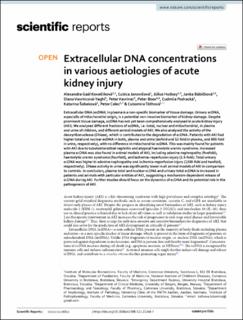| dc.description.abstract | Extracellular DNA (ecDNA) in plasma is a non-specific biomarker of tissue damage. Urinary ecDNA, especially of mitochondrial origin, is a potential non-invasive biomarker of kidney damage. Despite prominent tissue damage, ecDNA has not yet been comprehensively analysed in acute kidney injury (AKI). We analysed different fractions of ecDNA, i.e. total, nuclear and mitochondrial, in plasma and urine of children, and different animal models of AKI. We also analysed the activity of the deoxyribonuclease (DNase), which is contributes to the degradation of ecDNA. Patients with AKI had higher total and nuclear ecDNA in both, plasma and urine (sixfold and 12-fold in plasma, and 800-fold in urine, respectively), with no difference in mitochondrial ecDNA. This was mainly found for patients with AKI due to tubulointerstitial nephritis and atypical haemolytic uremic syndrome. Increased plasma ecDNA was also found in animal models of AKI, including adenine nephropathy (fivefold), haemolytic uremic syndrome (fourfold), and ischemia–reperfusion injury (1.5-fold). Total urinary ecDNA was higher in adenine nephropathy and ischemia–reperfusion injury (1300-fold and twofold, respectively). DNase activity in urine was significantly lower in all animal models of AKI in comparison to controls. In conclusion, plasma total and nuclear ecDNA and urinary total ecDNA is increased in patients and animals with particular entities of AKI, suggesting a mechanism-dependent release of ecDNA during AKI. Further studies should focus on the dynamics of ecDNA and its potential role in the pathogenesis of AKI. | en_US |

